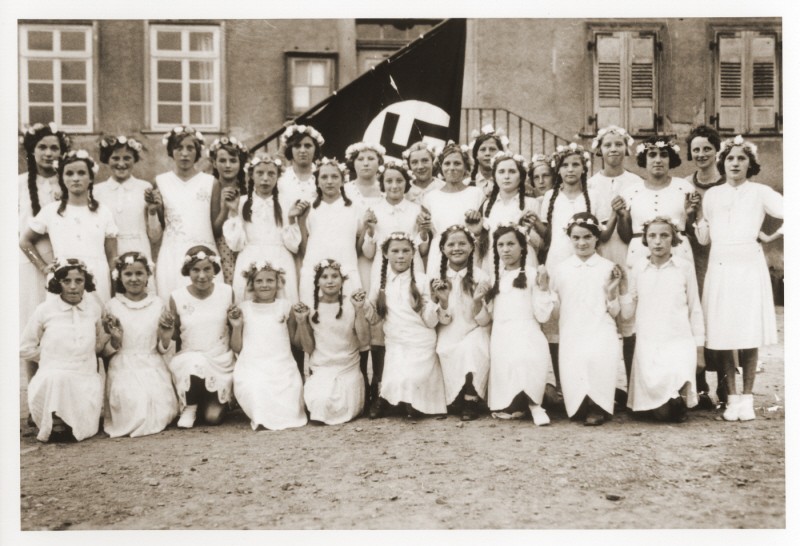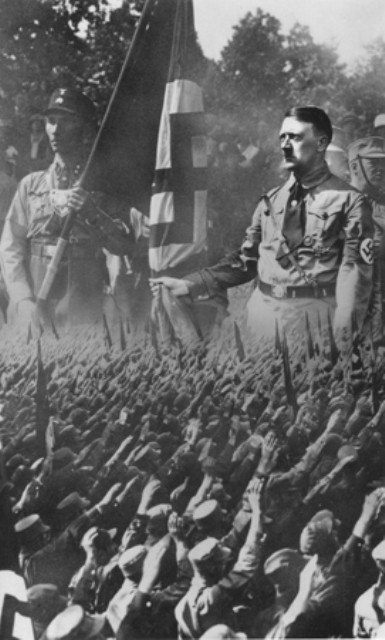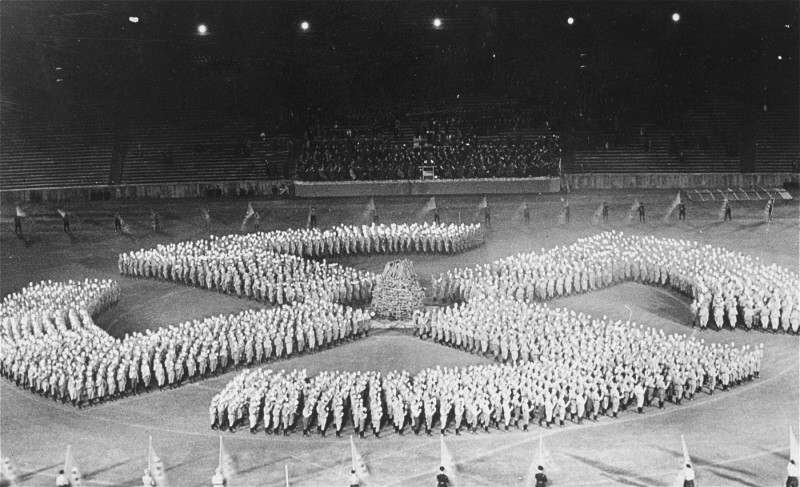
The History of the Swastika
The swastika is an ancient symbol that was used in many different cultures for at least 5,000 years before Adolf Hitler made it the centerpiece of the Nazi flag. Its present-day use by certain extremist groups promotes hate.
Key Facts
-
1
The swastika was long used as a symbol of well-being in ancient societies, including those in India, China, Africa, the Americas, and Europe.
-
2
Adolf Hitler designed the Nazi flag in 1920. He combined the swastika with the three colors of the German Imperial flag (red, black, and white).
-
3
Nazi symbols, including the swastika flag, are banned in a number of countries today, including Germany.
The Origins of the Swastika
The word swastika comes from the Sanskrit svastika, which means “good fortune” or “well-being." The motif (a hooked cross) appears to have first been used in Eurasia, as early as 7,000 years ago, perhaps representing the movement of the sun through the sky. To this day, it is a sacred symbol in Hinduism, Buddhism, Jainism, and Odinism. It is a common sight on temples or houses in India or Indonesia. Swastikas also have an ancient history in Europe, appearing on artifacts from pre-Christian European cultures.
Resurgence and Meanings of the Swastika in Modern Europe
The swastika experienced a resurgence in the nineteenth century, due to growing European interest in the ancient civilizations of the Near East and India. During his extensive excavations, the German archaeologist Heinrich Schliemann discovered the hooked cross on the site of ancient Troy. He connected it with similar shapes found on pottery in Germany and speculated that it was a “significant religious symbol of our remote ancestors.” Other European scholars and thinkers linked the symbol to a shared Aryan culture that spanned Europe and Asia.
In the beginning of the twentieth century the swastika was widely used in Europe. It had numerous meanings, the most common being a symbol of good luck and prosperity.
The Appropriation of the Swastika as a Nazi Symbol

However, the work of European linguists and other scholars was taken up by racist groups, for whom the swastika was a symbol of “Aryan identity” and German nationalist pride. This conjecture of Aryan cultural descent of the German people is likely one of the main reasons why the Nazi Party formally adopted the swastika or, what was also called in German, Hakenkreuz (literally, "hooked cross") as its symbol in 1920.
The Nazi Party was not the only party to use the swastika in Germany. After World War I, a number of far-right nationalist movements adopted the swastika. As a symbol, it became associated with the idea of a racially “pure” state. By the time the Nazis gained control of Germany, the connotations of the swastika had forever changed.
In Mein Kampf, Adolf Hitler wrote:
“I myself, meanwhile, after innumerable attempts, had laid down a final form; a flag with a red background, a white disk, and a black swastika in the middle. After long trials I also found a definite proportion between the size of the flag and the size of the white disk, as well as the shape and thickness of the swastika.”

The color scheme for the Nazi flag intentionally drew on the colors of the flag of Imperial Germany (1871–1918), which still resonated with many Germans who rejected democracy and the Weimar Republic. The color combination with the swastika symbol made for a powerful logo, a trademark that became indelibly linked with the Nazi Party. Most political parties in democratic Germany did not have a political logo; the Communist Party and the Nazi Party were exceptions.
The swastika became the most recognizable symbol of Nazi propaganda, appearing on the flag referred to by Hitler in Mein Kampf, as well as on election posters, arm bands, medallions, and badges for military and other organizations. A potent symbol intended to elicit pride among those who identified as Aryans, the swastika also struck terror into Jews and others deemed enemies of Nazi Germany.
Nazi Symbol: The Swastika in the Third Reich
Shortly after Hitler's rise to power in 1933, the Nazi regime replaced the constitutionally-mandated black-red-gold flag of the Weimar Republic which had been linked with Germany’s democratic traditions. On March 12, 1933, President Paul von Hindenburg and Adolf Hitler issued a decree stating that henceforth the old German Imperial flag (black-white-red) was to be flown together with the swastika flag. “These flags,” the edict spelled out,
“connect the glorious past of the German Empire to the powerful rebirth of the German nation. Together they embody the power of the state and the inner solidarity of the national circles of the German people!”

Two months later, on May 19, 1933, the Nazi government prohibited the “symbols of German history, of the German state, and of the national revolution from being publicly used in a way that was likely to damage the feeling of dignity of these symbols.” The legislation was aimed at preventing private advertisers, companies, and others from using the swastika and other Nazi symbols or images in marketing their commercial goods and services without the approval of the regime. At that point the German market was flooded with products—including coffee, cigarettes, and cake pans—emblazoned with swastikas, Hitler’s face, or other symbols. The new law made the producers of unauthorized products subject to criminal proceedings.
The Reich Flag and the Nuremberg Race Laws
At the annual Nazi Party rally in Nuremberg in September 1935, the German government passed new legislation aimed at further disenfranchising Germany’s Jews. Included among the so-called Nuremberg Race Laws was the Reich Flag Law (September 15, 1935) that declared that henceforth the swastika flag would constitute the official national flag of the German Reich. That same day, the government passed the Law for the Protection of German Blood and German Honor, which prohibited marriages and sexual relations between citizens of “German or those of kindred blood” and Jews. A further stipulation spelled out that Jews were banned from raising the new German flag (the swastika) and displaying the national colors.
The impetus behind the Reich Flag Law was the Nazi regime’s anger over events in New York in the summer and fall of 1935. On July 26, several hundred anti-Nazi demonstrators assembled around the German passenger liner, the SS Bremen, then docked at New York’s pier, to protest recent anti-Jewish incidents in Berlin. A group of protesters ripped the swastika banner from the ship’s bow and tossed it into the river. New York police arrested several of the demonstrators. The German government promptly issued a formal protest to US authorities.
In response to a judicial ruling that freed most of the defendants, the Nazi government passed the Reich Flag Law.
Postwar Bans on the Use of the Swastika and Cultural Controversies
Following Nazi Germany’s defeat in 1945, the Allied governments ruling the nation outlawed Nazi organizations. Their symbols and propaganda were removed and further dissemination criminalized. Subsequent German governments continued the ban on Nazi symbols and propaganda, including the swastika. Today in Germany and other European states, public display of Nazi symbols, including on the Internet, is restricted by law and individuals violating such terms may be subject to criminal proceedings.
In the United States, it is legal to display Nazi symbols and propaganda because of the country’s traditions and laws protecting free speech.
At various times and in various nations, the swastika has become a controversial cultural icon. Some motorcycle gangs in the United States beginning in the 1950s wore Nazi insignia to highlight their outlaw nature. In the late 1970s, some punk rock performers and enthusiasts openly displayed the swastika as a symbol of youthful rebellion against the status quo.
Sometimes, Nazi symbols take on neutral or even positive connotations in countries with little or no connection to the history of Nazi ideology and mass murder. The swastika as a symbol of Nazism, other Nazi signs, and even the figure of Adolf Hitler have taken on new life in some countries, where they have come to signify national unity, strength, discipline, anti-colonialism, and law and order. Symbols such as the swastika have a long history. To avoid misunderstanding and misuse, individuals should consider the context and past use of Nazi symbols and symbols in general.
Critical Thinking Questions
How can flags, labels, and symbols contribute to the rise of an ideology?
How is the swastika used today? How might the use of the swastika be hurtful or inflammatory?

